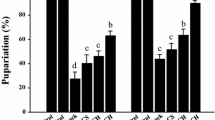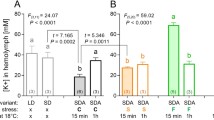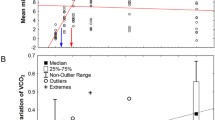Abstract
The capacity to undergo rapid the cold-hardening response (RCH) has been documented in diverse groups of insects and functions to protect against non-freezing cold injury and to preserve physiological performance in response to environmental cooling. The RCH response is remarkable for the rapidity of its induction; however the mechanism by which insects perceive cold and transduce this input at the cellular level has received little attention. To test the hypothesis that cells from isolated tissues can undergo RCH in response to cold, we assessed cell viability in four tissues that had undergone either RCH (0°C, 2 h followed by −8 °C, 2 h) or cold-shock (−8 °C, 2 h) both in vivo and in vitro from the adult flesh fly Sarcophaga crassipalpis (Diptera: Sarcophagidae) using fluorescent probes. Adult flies showed a significantly higher survival rate in the RCH group than in the cold-shocked group. Similarly, in all tissues tested, both in vivo and in vitro, RCH significantly improved cell survival compared with the respective cold-shocked groups. To our knowledge this is the first report to demonstrate that isolated cells and tissues from insects can undergo RCH. These results indicate that insect cells are capable of cold-sensing without neuroendocrine mediation; direct induction at the cellular level also helps to explain the swiftness of the RCH response.


Similar content being viewed by others
References
Broufas GD, Koveos DS (2001) Cold hardiness characteristics in a strain of the predatory mite Euseius (Amblyseius) finlandicus (Acari: Phytoseiidae) from Northern Greece. Ann Entomol Soc Am 94:82–90
Chen C-P, Denlinger DL, Lee RE (1987) Cold-shock injury and rapid cold hardening in the flesh fly Sarcophaga crassipalpis. Physiol Zool 60:297–304
Denlinger DL, Lee RE (1998) Physiology of cold sensitivity. In: Hallman GJ, Denlinger DL (eds) Temperature sensitivity in insects and application in integrated pest management. Westview Press, Boulder, pp 55–95
Denlinger DL, Yocum GD (1998) Physiology of heat sensitivity in insects. In: Hallman GJ, Denlinger DL (eds) Temperature sensitivity in insects and application in integrated pest management. Westview Press, Boulder, pp 7–33
Feder ME, Krebs RA (1997) Ecological and evolutionary physiology of heat shock proteins and the stress response in Drosophila: complementary insights from genetic engineering and natural variation. In: Bijlsma R, Loeschka V (eds) Environmental stress, adaptation and evolution. Birkhauser-Verlag, Basel, Switzerland, pp 155–173
Kelty JD, Lee RE (1999) Induction of rapid cold hardening by cooling at ecologically relevant rates in Drosophila melanogaster. J Insect Physiol 45:719–726
Kelty JD, Lee RE (2001) Rapid cold-hardening of Drosophila melanogaster (Diptera:Drosophilidae) during ecologically based thermoperiodic cycles. J Exp Biol 204:1659–1666
Lee RE, Denlinger DL (1985) Cold tolerance in diapausing and non-diapausing stages of the flesh fly, Sarcophaga crassipalpis. Physiol Entomol 10:309–315
Lee RE, Chen CP, Denlinger DL (1987) A rapid cold-hardening process in insects. Science 238:1415–1417
Monroy AF, Dhindsa RS (1995) Low-temperature signal transduction: induction of cold acclimation-specific genes of alfafa by calcium at 25°C. Plant Cell 7:321–331
Rinehart JP, Yocum GD, Denlinger DL (2000) Developmental upregulation of inducible hsp70 transcripts, but not the cognate form, during pupal diapause in the flesh fly, Sarcophaga crassipalpis. Insect Biochem Molec Biol 30:515–521
Shreve SM, Kelty JD, Lee RE (2004) The preservation of reproductive behaviors during modest cooling: rapid cold-hardening fine-tunes organismal response. J Exp Biol (in press)
Smallwood M, Bowels DJ (2002) Plants in a cold climate. Phil Trans R Soc London B357:831–847
Watanabe M, Kikawada T, Minagawa N, Yukuhiro F, Okuda T (2002) Mechanism allowing an insect to survive complete dehydration and extreme temperatures. J Exp Biol 205:2799–2802
Yi S-X, Lee RE (2003) Detecting freeze injury and seasonal cold-hardening of cells and tissues in the gall fly larvae, Eurosta solidaginis (Diptera: Tephritidae) using fluorescent vital dyes. J Insect Physiol 49:999–1004
Yi S-X, Yin C-M, Nordin JH (1987) The in vitro biosynthesis and secretion of glycerol by larval fat bodies of chilled Ostrinia nubilalis. J Insect Physiol 33:523–528
Acknowledgements
This research was supported by grants from the NSF (IBN-0090204 and IBN-0416720). The experiments described herein comply with the laws of the United States of America. We thank Shannon Pinkston for assistance in maintaining the fly colony.
Author information
Authors and Affiliations
Corresponding author
Additional information
Communicated by G. Heldmaier
Rights and permissions
About this article
Cite this article
Yi, SX., Lee, R.E. In vivo and in vitro rapid cold-hardening protects cells from cold-shock injury in the flesh fly. J Comp Physiol B 174, 611–615 (2004). https://doi.org/10.1007/s00360-004-0450-4
Accepted:
Published:
Issue Date:
DOI: https://doi.org/10.1007/s00360-004-0450-4




